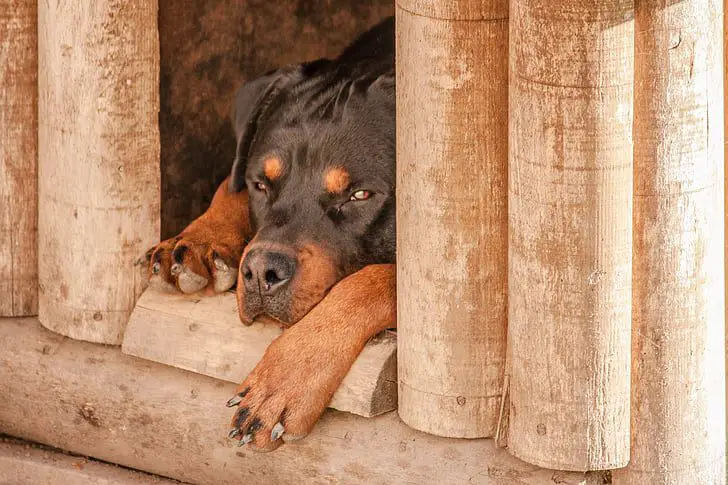As pet owners, we want to provide the best possible living environment for our canine companions. One question that often arises is whether dogs belong inside or outside.
The answer isn’t a simple one-size-fits-all, as various factors come into play, such as breed, climate, and individual needs.
In this article, we’ll explore the pros and cons of indoor and outdoor living for dogs, discuss the importance of proper shelter, exercise, and social interaction, and help you determine the most suitable arrangement for your furry friend.
Key Takeaway
| Factors | Indoor Dogs | Outdoor Dogs |
|---|---|---|
| Breed & Size | Small breeds, senior dogs, short coats | Working dogs, livestock guardian dogs, large size, thick coats |
| Socialization | Better opportunities for interaction with family members | Require regular interaction with owners to prevent boredom and behavioral issues |
| Safety & Security | Protection from hazards, predators, and theft | Need a secure, well-fenced yard, and proper shelter |
| Health | Less likely to contract diseases or parasites | More susceptible to parasites, require regular veterinary care |
| Climate & Weather | Better suited for temperature-sensitive breeds | Must provide a weatherproof shelter and protection from extreme weather conditions |
Do Dogs Belong Inside or Outside?

Dogs can thrive both inside and outside, but the best option depends on various factors such as breed, size, temperament, and the owner’s lifestyle.
Here are some points to consider when deciding whether a dog should live indoors or outdoors:
Indoor dogs:
- Small breeds, senior dogs, and dogs with short coats typically fare better indoors due to their sensitivity to extreme temperatures.
- Indoor living provides better opportunities for socialization, mental stimulation, and bonding with family members.
- Dogs living indoors are less likely to contract diseases or parasites from other animals.
- Indoor dogs are generally safer from hazards such as traffic, predators, and theft.
Outdoor dogs:
- Some breeds, like working or livestock guardian dogs, are more suited to outdoor living due to their size, coat type, and natural instincts.
- Outdoor dogs require a secure, well-fenced yard, access to a shelter, and regular interaction with their owners to prevent boredom and behavioral issues.
- Dogs living outdoors need to be monitored for health issues, such as fleas, ticks, and other parasites.
- Larger properties or rural areas may provide a more suitable environment for active, outdoor dogs.
Ultimately, the decision should be based on the individual dog’s needs and the owner’s ability to provide a safe, healthy, and comfortable environment. Proper training, socialization, and regular exercise are essential for all dogs, regardless of whether they live indoors or outdoors.
Do Dogs Like Being Kept Outside?

Some dogs may like being kept outside, especially if they are bred for outdoor work or have physical attributes suited for outdoor living. However, individual preferences vary, and it’s essential to ensure they have a safe, comfortable environment and receive proper care and socialization.
Dogs have individual preferences, and some may enjoy being outside more than others.
However, there are certain factors that can influence a dog’s comfort and happiness when kept outdoors.
Here are some points to consider:
- Breed and physical attributes: Some breeds, like working dogs or livestock guardian dogs, are better suited to outdoor living due to their size, coat type, and natural instincts. Dogs with thick coats may tolerate colder temperatures better than those with short coats.
- Socialization and companionship: Dogs are social animals and need regular interaction with their owners and other dogs. If a dog is kept outside without adequate socialization, it may develop behavioral issues or become anxious and unhappy.
- Safety and security: A safe and secure outdoor environment is essential for a dog’s well-being. The area should be well-fenced, free from hazards, and provide access to shelter in case of inclement weather.
- Stimulation and exercise: Dogs need mental stimulation and physical exercise to stay happy and healthy. Outdoor dogs should have access to toys, activities, and regular walks or play sessions with their owners.
- Healthcare: Outdoor dogs may be more susceptible to parasites and diseases, so regular veterinary care, vaccinations, and preventative measures such as flea and tick control are crucial.
While some dogs may enjoy being outside, it’s essential to ensure they have a suitable environment, proper care, and regular interaction with their owners.
Remember that dogs’ preferences and needs can change over time, so it’s important to monitor their well-being and adjust their living arrangements accordingly.
Can a Dog Live Outside
Yes, a dog can live outside, but it depends on various factors such as breed, climate, and proper shelter. Some dog breeds are more suited to living outdoors due to their size, coat type, and adaptability.
However, it is important to ensure that your dog has a well-insulated and weatherproof shelter, access to fresh water, and a secure area to prevent them from escaping or getting injured.
It’s crucial to remember that dogs are social animals, and they thrive on companionship and interaction with their human family. If you’re considering having your dog live outside, make sure to spend quality time with them daily and provide mental stimulation through play, training, and exercise.
Regular veterinary check-ups and proper grooming are also essential for maintaining your dog’s health and well-being.
Ultimately, while some dogs can live outside, it’s always best to assess your specific situation and consider the needs of your individual dog before making a decision.
Is It Mean To Leave Your Dog Outside?
Yes. Leaving your dog outside without a proper shelter can be considered mean or neglectful if its physical, emotional, and social needs are not met.
Dogs are social animals that require companionship, mental stimulation, and regular interaction with their human family.
If a dog is left outside without proper shelter, access to clean water, protection from extreme weather conditions, or opportunities for socialization and exercise, it can lead to negative consequences such as stress, anxiety, behavioral issues, and health problems.
If you need to leave your dog outside for extended periods, ensure they have a comfortable, insulated, and weatherproof shelter, as well as access to fresh water and a secure area to prevent escape or injury. Additionally, devote time each day to interact, play, and exercise with your dog to maintain their overall well-being.
In summary, leaving a dog outside can be considered mean if it leads to neglect of their basic needs. It’s essential to evaluate your individual situation and your dog’s specific requirements before deciding on the most suitable living arrangement.
Is It Bad To Keep Your Dog Inside All The Time?
It is not ideal to keep your dog inside all the time, as dogs require physical exercise, mental stimulation, and social interaction to maintain their overall health and well-being.
Constant confinement indoors can lead to various issues such as obesity, anxiety, boredom, and destructive behaviors.
To ensure your dog’s well-being, it is essential to provide them with regular outdoor activities, including daily walks, playtime, and opportunities to socialize with other dogs and people.
These activities help in keeping your dog physically fit, mentally stimulated, and emotionally balanced.
However, it is also crucial to provide a safe and comfortable indoor environment for your dog, where they can rest and feel secure. Striking a balance between indoor and outdoor life is essential for your dog’s overall health and happiness.
Remember to consider your dog’s breed, age, and individual needs when determining the appropriate amount of time spent indoors versus outdoors.
Should I Leave My Dog Inside or Outside While at Work?
Deciding whether to leave your dog inside or outside while at work depends on several factors, including your dog’s breed, age, temperament, and the safety of your indoor and outdoor environments.
Here are some considerations to help you make the best decision for your dog:
Leaving your dog inside:
- Ensure your dog has a comfortable space to rest and access to fresh water.
- Provide toys and puzzle feeders for mental stimulation and to prevent boredom.
- Make sure your home is dog-proofed to avoid accidents and prevent destructive behaviors.
- Consider hiring a dog walker or asking a friend or neighbor to take your dog for a walk during the day.
Leaving your dog outside:
- Make sure your dog has a secure, weatherproof, and insulated shelter to protect them from the elements.
- Provide access to fresh water and shade in hot weather.
- Ensure your yard is secure and free from hazards, including toxic plants, chemicals, and escape routes.
- Consider using a dog run or a fenced area to keep your dog safe and contained.
Regardless of whether you choose to leave your dog inside or outside while at work, it’s essential to ensure their physical, mental, and emotional needs are met.
Prioritize spending quality time with your dog before and after work, engaging in activities such as walks, playtime, and training to maintain their overall well-being.
Dog Breeds That Can Sleep Outside
Here is a list of some dog breeds that are better suited for sleeping outside due to their size, coat type, and adaptability.
However, it’s crucial to provide proper shelter, access to fresh water, and a secure area for any dog living outdoors.
- Alaskan Malamute
- Siberian Husky
- Bernese Mountain Dog
- Great Pyrenees
- Newfoundland
If you wish to see the full list, these dog breeds can sleep outside.
In Conclusion
In conclusion, deciding whether a dog belongs inside or outside depends on several factors, including the dog’s breed, age, temperament, and specific living environment.
The primary concern should always be the well-being and safety of your canine companion.
Both indoor and outdoor living arrangements have their advantages and challenges. Striking a balance between the two might be the best option for most dogs.





Leave a Reply